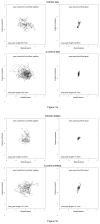Mechanisms of postural control in alcoholic men and women: biomechanical analysis of musculoskeletal coordination during quiet standing
- PMID: 20028360
- PMCID: PMC2858249
- DOI: 10.1111/j.1530-0277.2009.01118.x
Mechanisms of postural control in alcoholic men and women: biomechanical analysis of musculoskeletal coordination during quiet standing
Abstract
Background: Excessive sway during quiet standing is a common sequela of chronic alcoholism even with prolonged sobriety. Whether alcoholic men and women who have remained abstinent from alcohol for weeks to months differ from each other in the degree of residual postural instability and biomechanical control mechanisms has not been directly tested.
Method: We used a force platform to characterize center-of-pressure biomechanical features of postural sway, with and without stabilizing conditions from touch, vision, and stance, in 34 alcoholic men, 15 alcoholic women, 22 control men, and 29 control women. Groups were matched in age (49.4 years), general intelligence, socioeconomic status, and handedness. Each alcoholic group was sober for an average of 75 days.
Results: Analysis of postural sway when using all 3 stabilizing conditions versus none revealed diagnosis and sex differences in ability to balance. Alcoholics had significantly longer sway paths, especially in the anterior-posterior direction, than controls when maintaining erect posture without balance aids. With stabilizing conditions the sway paths of all groups shortened significantly, especially those of alcoholic men, who demonstrated a 3.1-fold improvement in sway path difference between the easiest and most challenging conditions; the remaining 3 groups, each showed a approximately 2.4-fold improvement. Application of a mechanical model to partition sway paths into open-loop and closed-loop postural control systems revealed that the sway paths of the alcoholic men but not alcoholic women were characterized by greater short-term (open-loop) diffusion coefficients without aids, often associated with muscle stiffening response. With stabilizing factors, all 4 groups showed similar long-term (closed loop) postural control. Correlations between cognitive abilities and closed-loop sway indices were more robust in alcoholic men than alcoholic women.
Conclusions: Reduction in sway and closed-loop activity during quiet standing with stabilizing factors shows some differential expression in men and women with histories of alcohol dependence. Nonetheless, enduring deficits in postural instability of both alcoholic men and alcoholic women suggest persisting liability for falling.
Figures






References
-
- American Psychiatric Association. Diagnostic and Statistical Manual of Mental Disorder (DSM-IV) American Psychiatric Association; Washington: 1994.
-
- Baloh RW, Ying SH, Jacobson KM. A longitudinal study of gait and balance dysfunction in normal older people. Arch Neurol. 2003;60(6):835–839. - PubMed
-
- Beatty WW, Hames KA, Blanco CR, Nixon SJ, Tivis LJ. Visuospatial perception, construction and memory in alcoholism. J Stud Alcohol. 1996;57:136–143. - PubMed
-
- Collins JJ, De Luca CJ. Open-loop and closed-loop control of posture: A random-walk analysis of center-of-pressure trajectories. Exp Brain Res. 1993;95:308–318. - PubMed
-
- Collins JJ, De Luca CJ. Upright, correlated random walks: A statistical-biomechanics approach to the human postural control system. Chaos. 1995;5(1):57–63. - PubMed
Publication types
MeSH terms
Grants and funding
LinkOut - more resources
Full Text Sources
Medical

